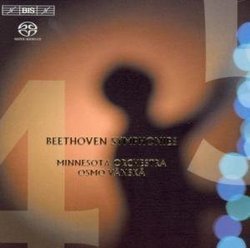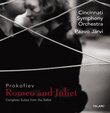| All Artists: Ludwig van Beethoven, Osmo Vänskä, Osmo Vanska, Minnesota Orchestra Title: Beethoven Symphonies 4 & 5 Members Wishing: 0 Total Copies: 0 Label: Bis Original Release Date: 1/1/2005 Re-Release Date: 1/25/2005 Album Type: Hybrid SACD - DSD Genre: Classical Styles: Historical Periods, Classical (c.1770-1830), Symphonies Number of Discs: 1 SwapaCD Credits: 1 UPC: 675754809423 |
Search - Ludwig van Beethoven, Osmo Vänskä, Osmo Vanska :: Beethoven Symphonies 4 & 5
 | Ludwig van Beethoven, Osmo Vänskä, Osmo Vanska Beethoven Symphonies 4 & 5 Genre: Classical
|
Larger Image |
CD DetailsSimilar CDs |
CD ReviewsA pleasant version of updated Beethoven, leaving out the her Santa Fe Listener | Santa Fe, NM USA | 01/17/2009 (3 out of 5 stars) "I fear that the bandwagon effect is at work among the five-star brigade at Amazon. Osmo Vanska has won widespread, at times extravagant praise for his now complete Beethoven cycle from Minnesota. That would lead a prospective buyer to expect something new, revolutionary, groundbreaking, and invidivual in this pairing of Sym. #4 and #5. I don't hear that at all. This sounds like a pleasant, well drilled, slightly updated version of the period style which began in the Eighties with Roger Norrington and John Eliot Gardiner. But Vanska is blander than either. In the concert hall, you will never hear a major orchestra play flat-out in period style, but tempos have sped up, and here and there a major conductor (Rattle, Abbado, Haitink) has absorbed more of the style, reducing the string body, asking for hard sticks on the timpani, and lessening violin vibrato. But all of that is superficial. The important thing is to convey the indomitable spirit of Beethoven, who didn't see himself as pumped-up Haydn, which is what we have here. Beethoven was a full-blown revolutionary, and trying to squeeze him back into the box of pre-1800 classicism makes no sense. Since the Fourth is the more lyrical and graceful of these two symphonies, Vanska's diluted interpretation is easier to take. The first movement is conventional in tempo, as is the flowing Adagio, here taken as an Andante, which sings nicely. The wind soloists are pleasant without being virtuosic in any way, but virtuosity isn't a must here. The Scherzo is not exceptionally fast, but Vanska has ironed out Beethoven's accents and produced a rather bland result. The finale, taken at normal tempo, is subdued too much -- it's controlled instead of rollicking or abandoned. In all, a performance that is innocuous and smooth. (If you want to hear a revoluitnary stab at the Fourth, look for Carlos Kleiber's live reading on Orfeo.) The Fifth is a cornerstone of the Romantic movement, so diluting it feels wrong to me. Vanska's approach is Szell-lite: he keeps a steady tempo, eschew expressive rubato, and aims for precision and discipline. I can see why a whole school of listeners would prefer this style even if I don't. What I can't see is waxing ecstatic over such a cautious version of it when you can have Szell, Toscanini, and Erich Kleiber at full strength. Vanska deliberately drains the first and last movements of power, excitement, and heroism. Tempos are convenitonal throughout; the temperature is low. The playing is plesant, and the phrasing goes down easily. If that's enough to satisfy you, as apparently it satisfies many listeners, I can't argue. Tastes change. But I thought it was worthwhile for newcomers to know what they are in for, in case they had heard that Toscanini and Furtwanglr had met their match." Osmo Vanska and Beethoven's 4th and 5th Hubert S. Mickel | 10/04/2007 (5 out of 5 stars) "I began listening to this recording on the radio and was attracted to the precision of the playing, how clear the inner, middle voices were, and felt that I was unable to identify the orchestra. The playing was a bit heavy handed, which goes fine with Beethoven, and thought maybe it was Berlin or Vienna, since they tend to play that way. The strings sounded to me like it was a European orchestra. American orchestras, e.g. Boston, have string sections in which the bowing is dramatically varied in the same section. This sounded as if they were all together. The individual instruments: winds, strings, and brass played truly virtuoso passages. After learning that it was Osma Vanska and the Minnesota Orchestra, I sent for the disc. The BIS label has historically had some great performances. When I was collecting LP's, I acquired the first 200+ LP's that they had on their label. Getting a BIS CD seems appropriate, especially since one is getting a truly outstanding performance, by an American orchestra. What is important about this recording is that it does not sound like anyone else's. Vanska gets what he wants from this orchestra, and it is great! To anyone wishing to hear a new but still clearly authentic interpretation of the Beethoven symphonies #4 and #5 should get this CD. Most highly recommended." Simply the Best 5th T. Carlsen | 03/03/2008 (5 out of 5 stars) "There is no such thing as "the best" recording of Beethoven symphonies. However, this is the best recording of Beethoven's Fifth I have heard. The strings have a unified "voice" that is hard to describe but very affecting.
This recording of the Fifth is not a nuclear blast from beginning to end, but rather, the changes in dynamics are remarkable, creating a sense of life as the dynamics fluctuate from elegance and beauty to power. I believe that Vanska's strategy was to study Beethoven's manuscripts carefully and follow the master, and he achieved brilliance. As another reviewer mentioned, this sounds like a European orchestra. It received rave reviews, including a rare designation from Gramophon as a very special recording. This stands among the top Beethoven's Fifth recordings. Highest recommendation! If you listen to this recording, you will agree that it is astonishing." |

 Track Listings (8) - Disc #1
Track Listings (8) - Disc #1